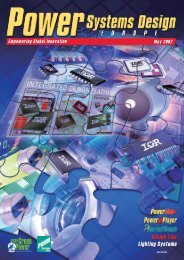Powering Freight & Transportation - Power Systems Design
Powering Freight & Transportation - Power Systems Design
Powering Freight & Transportation - Power Systems Design
Create successful ePaper yourself
Turn your PDF publications into a flip-book with our unique Google optimized e-Paper software.
20<br />
DESIGN TIPS<br />
<strong>Power</strong> Supply Control<br />
<strong>Design</strong> Tools – Part VI<br />
Modeling <strong>Power</strong> Supplies with<br />
Current-Mode Control<br />
The buck-boost converter (or flyback<br />
converter in its isolated version) is the<br />
most popular converter for generating<br />
low power with multiple output voltage<br />
levels. The converter can be run in<br />
many different modes – discontinuous<br />
conduction mode (DCM), continuous<br />
conduction mode(CCM), quasi-resonant<br />
mode (DCM with switching at the bottom<br />
of the DCM ring wave), and various<br />
options of fixed or variable frequency.<br />
The choice of operation depends on<br />
the power level, the application, and the<br />
control chip used.<br />
Regardless of the mode of operation<br />
of the power stage, current-mode<br />
control is almost always used, as<br />
shown in Figure 1. Many designers<br />
strive to always keep their converter<br />
in DCM in order to avoid some of the<br />
complexities of control. This is not<br />
necessary if current mode control is<br />
used, and keeping the converter DCM<br />
under every condition of line and load<br />
can create large peak stresses in the<br />
semiconductors.<br />
While it is an intuitive control scheme,<br />
the proper analysis of current mode<br />
control is complex. The dynamic analysis<br />
of current mode involves advanced<br />
techniques, including discrete-time and<br />
sampled-data modeling. This is essential<br />
Buck-Boost Converter with<br />
Current-Mode Control<br />
In this article, Dr. Ridley presents a summary of current-mode control for the buck-boost converter.<br />
A free piece of analysis software, the final one in a series of six, is provided to readers of this column to<br />
aid with the analysis of their current-mode buck-boost converters.<br />
By Dr. Ray Ridley, Ridley Engineering<br />
to arrive at a model which explains all of<br />
the phenomena seen with your converter,<br />
and which accurately predicts the<br />
measured control-to-output response<br />
and loop gain of the current-mode converter.<br />
The full analysis of current-mode<br />
control can be downloaded from www.<br />
ridleyengineering.com.<br />
Figure 2 shows a plot of the control<br />
characteristics of the buck-boost converter<br />
in both DCM and CCM. Notice<br />
that these characteristics do not change<br />
very much at low frequencies, making<br />
control optimization straightforward for<br />
converters that must operate in both<br />
regions.<br />
There are several important points<br />
to learn from the full analysis of the<br />
current-mode boost converter:<br />
1. The power stage has a dominantpole<br />
response at low frequencies,<br />
determined mainly by the time constant<br />
of the output capacitor and load resistor<br />
values. This dominant pole response<br />
does not vary significantly as the converter<br />
moves from DCM to CCM operation,<br />
as can be seen in Figure 2.<br />
2. In CCM, the power stage has an<br />
additional pair of complex poles at half<br />
the switching frequency which, under<br />
certain conditions, will create instability<br />
in the current feedback loop. The<br />
damping of these complex poles is<br />
controlled by the addition of a compensating<br />
ramp.<br />
3. The resulting transfer function of the<br />
CCM power stage is third-order, even<br />
though there are only two state variables<br />
in the converter. (This apparent anomaly,<br />
for control theorists, is caused by the<br />
fact that the switching power converter<br />
is a nonlinear, time-varying system.)<br />
4. The second-order double poles at<br />
half the switching frequency cannot be<br />
ignored, even though they may be well<br />
beyond the predicted loop crossover<br />
frequency.<br />
5. The capacitor ESR zero is unchanged<br />
by the presence of the current<br />
loop feedback.<br />
<strong>Power</strong> <strong>Systems</strong> <strong>Design</strong> October 2008









